
Just a few of the hiking boots we tested for this guide. Photo: Steve Andrews//The Inertia
Hiking is one of the purest ways to find freedom in nature. And great hiking boots are crucial for getting out on the trail. The following guide will help you choose the best hiking boots for your budget, style, and intended purpose. Each pair listed here has gone through our rigorous testing process. Our testers are a crew of passionate hikers devoted to exploring the world’s best mountains and trails. We have been testing these boots year-round, making sure that we break them in properly and giving them plenty of time to demonstrate how they hold up to a variety of conditions, from rainforests to deserts to summits and beyond.
Navigate To: Comparison Table | Buyer’s Guide | How We Tested
Related: Best Hiking Boots for Women | Best Hiking Shoes | Other Hiking Gear Reviews
Editor’s Note: We updated this guide in June 2025 with updated formatting, additional navigation and photos, and refreshed links. We also removed out-of-stock or old-model hiking boots.
The Best Hiking Boots of 2025
Best Overall Hiking Boots: Lowa Renegade Evo GTX Mid
Runner-Up Best Overall Hiking Boots: Scarpa Kailash Trek GTX
Best Budget Hiking Boots: Merrell Moab 3 Mid WP
Best Women’s Hiking Boots: La Sportiva TX Hike Mid GTX
Best Quality Hiking Boots: Zamberlan Tofane NW GTX RR
Best Lightweight Hiking Boots: Xero Shoes Ridgeway
Best Overall Hiking Boots
Lowa Renegade Evo GTX Mid ($265)
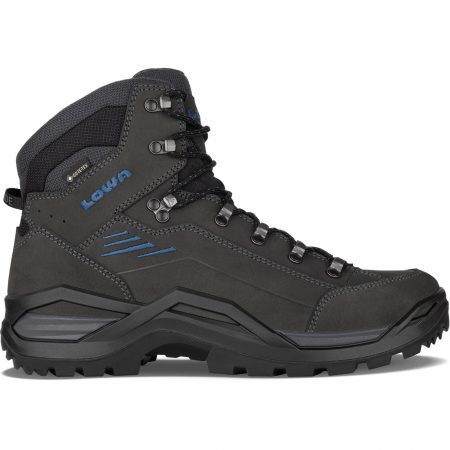
Available In: Men’s, Women’s
Weight: 20.3 oz
Upper Material: Nubuck Leather
Lining: GORE-TEX
Outsole: Vibram Evo Rubber
Pros: Excellent quality and durability, great value
Cons: Large soles feel like they should have stronger upper material to match
What surprised us most about the new Lowa Renegade Evo GTX was not only how well-made they are, but how comfortable they are right out of the box. Breaking them in only made that comfort increase. They are versatile, durable, and extremely supportive, and the update remains our favorite hiking boot this year.
The revamp has fewer seams on the upper for fewer points of wear, and the proprietary DYNAPU midsole offered some of the best comfort we found in a stiffer boot. They are durable, supportive, and will last a very long time. With Vibram outsoles and GORE-TEX waterproofing and breathability (we’re guessing the update also foregoes PFAS), these boots will perform well in any condition and keep your feet cozy as the miles stack up. The laces are easy to tie up and hold well despite trying our best to get them to loosen. The only thing we noticed was that although comfortable, the upper of these boots did not meet the rigidity of the midsole and outsole, making for a bit of an identity crisis on whether this boot was meant for more rugged hikes or something in the mid-range.
There isn’t much we can say that would hold us back from getting more pairs. Only that, if you’re not into serious hiking with a heavy pack, this might be too much boot for general day-hiking use. But if you want a pair of hiking boots that will keep you upright, handle miles upon miles of rough terrain, and stay dry as long as any boot can, then you’ll be happy in a pair of the new Renegade Evo.
Check Men's Price on REI Check Women's Price on REI
Runner-Up Best Overall Hiking Boots
Scarpa Kailash Trek GTX ($319)
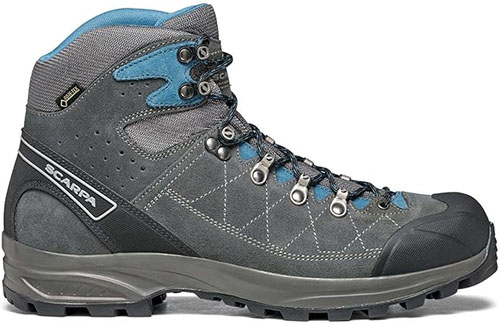
Available In: Men’s, Women’s
Weight: 21.5 oz
Upper Material: Suede and Nylon
Lining: GORE-TEX
Outsole: Vibram Biometric / XS Trek
Pros: Reinforced toe cap for added durability; steel lace hardware makes for a tight fit that lasts
Cons: Thick midsole gives a higher center of gravity
This boot just missed our “Best Overall” nod, with the affordability of the Lowa being the standout difference. But for someone who wants a do-all, go-anywhere boot, you can’t go wrong with the Scarpa Kailash Trek GTX.
Hordes of devoted fans agree; it’s Scarpa’s best-selling hiking boot for many years. And that’s saying something. Scarpa is based in Italy, where hiking is a religion, and the competition among quality hiking boots is as stiff as it gets. The Scarpa designers have come close to perfection with this boot.
The GORE-TEX waterproofing never failed, no matter how hard we tried to get water inside. The boots felt great right out of the box and handled an 11-mile hike in Idaho’s Sawtooth Mountains without any soreness afterward.
With reinforced toe and heel pieces, this boot plays like a much more burly pair of hikers but still allows one to be nimble and agile, with or without a pack. Scarpa uses Euro sizing, which can be a bit confusing if you’re used to the North American sizes. So, if you’ve never had a pair and are unsure of the sizing, it’s wise to try on a pair first before buying to be totally sure.
Check Women's Price on Backcountry Check Women's Price on Amazon
Best Budget Hiking Boots
Merrell Moab 3 Mid WP ($150)
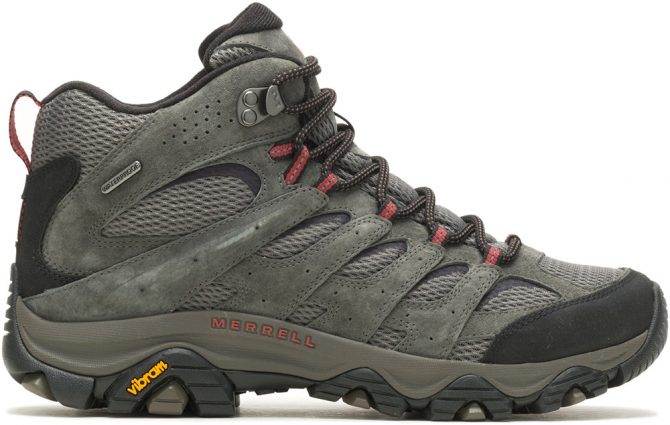
Available In: Men’s, Women’s
Weight: 16.5 oz
Upper Material: Pigskin/Mesh
Lining: Waterproof Membrane
Outsole: Vibram TC5+
Pros: Great value for price/quality, minimal break-in period
Cons: On the warmer side, waterproofing isn’t GORE-TEX
Merrell has been a staple in outdoor footwear since it started in 1983, and the Moab 3 is just the latest in the “Mother Of All Boots” (MOAB) line. The low-top is also a favorite in our Best Hiking Shoes, where we called it “the dad shoe of hiking.” And while that is a mild burn on this shoe’s styling, it also speaks to how versatile it is. The idea is that you can wear this boot for a wide variety of applications, be it hiking, yard work, or simply needing some extra support under your feet. Each iteration of this boot is a quality advancement on the last. The Moab 3’s newest additions include more cushioning and the use of partially recycled materials.
These boots felt nice right away. The upper is thicker than other boots we tested, which adds points on the comfort scale, yet felt a bit warm in the hot sun. If ventilation is a more important factor than waterproofing, Merrell does offer a more ventilated option, but you’ll have to sacrifice waterproofing for that. Also, note that the waterproofing used in this boot isn’t GORE-TEX. Merrell opted instead for a proprietary membrane. As such, the breathability was noticeably lower than some of the GTX boots we tested. So that’s where you’ll need to make a choice between waterproof and non-waterproof based on how wet the trails around you are.
It’s not an extremely technical boot. However, we’d venture to guess that the majority of people looking for a budget pair of hiking boots aren’t looking to crush any records on the Appalachian Trail. Unless you’re in need of a top-tier technical boot, then you can’t really go wrong with the Merrell Moab 3.
Read our review of the women’s Merrell Moab 3 here.
Check Men's Price on REI Check Men's Price on Backcountry
Check Women's Price on REI Check Women's Price on Backcountry
Best Women’s Hiking Boots
La Sportiva TX Hike Mid GTX Hiking Boots ($189)
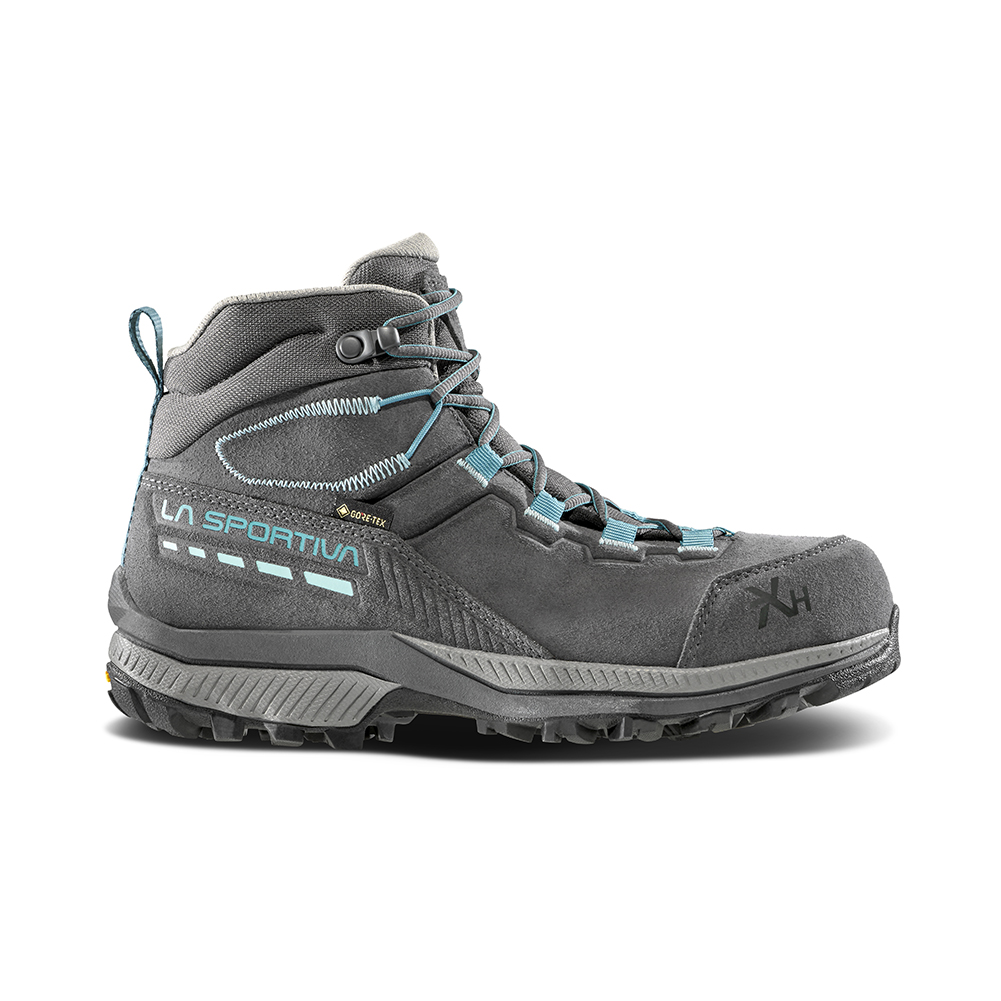
Available In: Men’s, Women’s
Weight: 14.2 oz
Upper Material: Recycled air mesh
Lining: GORE-TEX
Outsole: Vibram Ecostep Evo
Pros: Comfortable, break-in period is minimal
Cons: Wide fit may not be ideal for narrow feet
While a lot of high-quality hiking boots have a hefty break-in period, the La Sportiva X Hike Mid GTX Hiking Boots are comfortable right out of the gates — relatively speaking. Like any boots, they felt a little stiff on our first hike, but they didn’t present any issues and kept getting more comfortable with each use.
The TX Hike Mid GTX boots are eco-friendly: they sport a recycled collar lining, recycled and Bluesign-certified GORE-TEX lining, recycled laces and nylon webbing, 15% recycled EVA Midsole, 100% PFC-free leather treatment, and a Vibram Ecostep Evo Outsole with 30% recycled content. The GORE-TEX linings ensure these boots are waterproof while remaining breathable.
Inspired by trail running shoes, these boots have lightweight mesh on the uppers. The Vibram Ecostep EVO outsoles with Impact Brake System offer reliable traction on both wet and dry surfaces.
Our female tester has narrow feet, and the TX Hike Mid GTX Boots boast a wide, comfortable fit. So she was nervous they wouldn’t work, but found the boots cinched down for a great fit and performance on the trail. Supportive, comfortable, and durable, it’s safe to say we’re fans of the La Sportiva X Hike Mid GTX Hiking Boots.
Read our full review of the La Sportiva TX Hike here.
Check Women's Price on REI Check Women's Price on Backcountry
Check Men's Price on REI Check Men's Price on Backcountry
Best Quality Hiking Boots
Zamberlan Tofane NW GTX RR ($495)
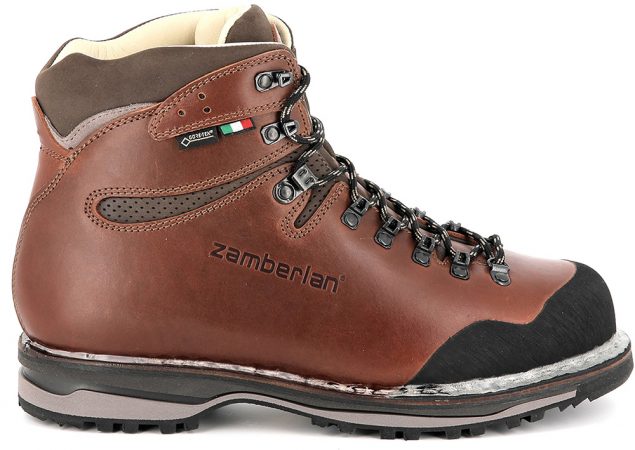
Available In: Men’s, Women’s
Weight: 29.5 oz
Upper Material: Waxed Tuscan leather
Lining: GORE-TEX
Outsole: Zamberlan Vibram NorWalk
Pros: Unbeatable, long-lasting comfort, can be re-soled for longer lifespan
Cons: Pricey, takes a while to break in, heavier than other models.
If your idea of a great time involves crossing major divides with a pack that could supply a small army regiment, the Zamberlan Tofane NW GTX RR could be the last boot you’ll ever buy. It’s one of those boots that the more you wear it, the better it will feel — the waxed Tuscan leather really does need a hefty break-in period. Add in a GORE-TEX membrane, and these boots are as waterproof and bomber as they come.
One of the last great torchbearers of the art of handmade boots, Zamberlan’s Norwegian welted construction is more than just a flex. This traditional technique stitches the upper to a leather welt and then to the sole, creating a durable and water-resistant bond. It also allows for resoling, meaning these boots can last for decades with proper care.
There really aren’t many downsides to share about this boot, other than at 29.5 oz they are the heaviest boots on our list. Sure, the price tag tops out as the highest of the boots we tested, but when is a handmade Italian leather boot ever cheap? You really do get what you pay for here.
That said, due to its weight and price, this is not a boot for day hikers. The Zamberlan Tofane NW GTX RR is meant for logging rugged miles on big overnights while carrying a heavy pack. If that is you, then an investment in these boots will end up paying dividends many years down the trail.
Check Men's Price on REI Check Men's Price on Backcountry
Best Lightweight Hiking Boots
Xero Shoes Ridgeway ($140)
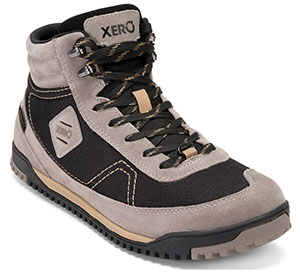
Available In: Men’s, Women’s
Weight: 13 oz
Upper Material: Suede/Polyester textile
Lining: Polyester textile
Outsole: FeelTrue Rubber
Pros: Lightweight, wide toe-box, zero-drop, great price
Cons: Laces get sticky when loosening and tightening
These boots are brand new this year from Xero Shoes, a minimalist shoe company with legions of loyal followers and a cult-like status. Their hiking boot offering, the Ridgeway, is built from scratch to give bigger hiking boots (both in size and status) a run for their money.
It’s lightweight at 13 ounces and sports a wide toe box that allows toes room to wiggle and stretch as you go about your day. It’s also waterproof, with Xero Shoes’ proprietary lining keeping the moisture out as we traversed through stream crossings and muddy puddles galore.
The main issue we found was in the flat laces — they are a pain to loosen up, especially if you’ve been on a dusty trail. So we recommend swapping them out for some round laces to make the experience more enjoyable.
The outsole is plenty durable (Xero Shoes offers a 5,000-mile warranty) yet remains thin enough to allow the bottom of the foot to respond to the ground underneath. The result? A more mindful step in nature that (some say) pays dividends.
Zero-drop or “barefoot” shoes and boots have no “drop” between the heel and the toe — traditional footwear often lifts the heel several millimeters above the toes, which advocates of zero-drop shoes claim to throw off body alignment. We won’t make any claims for or against here, but if you’ve been curious or are a fan of zero-drop footwear, it’s worth seeing how it feels.
Check Men's Price on REI Check Men's Price on Amazon
Check Women's Price on REI Check Women's Price on Amazon
Best of the Rest
Comfortable Max-Cushion Hiking Boots
Hoka Kaha 3 GTX ($240)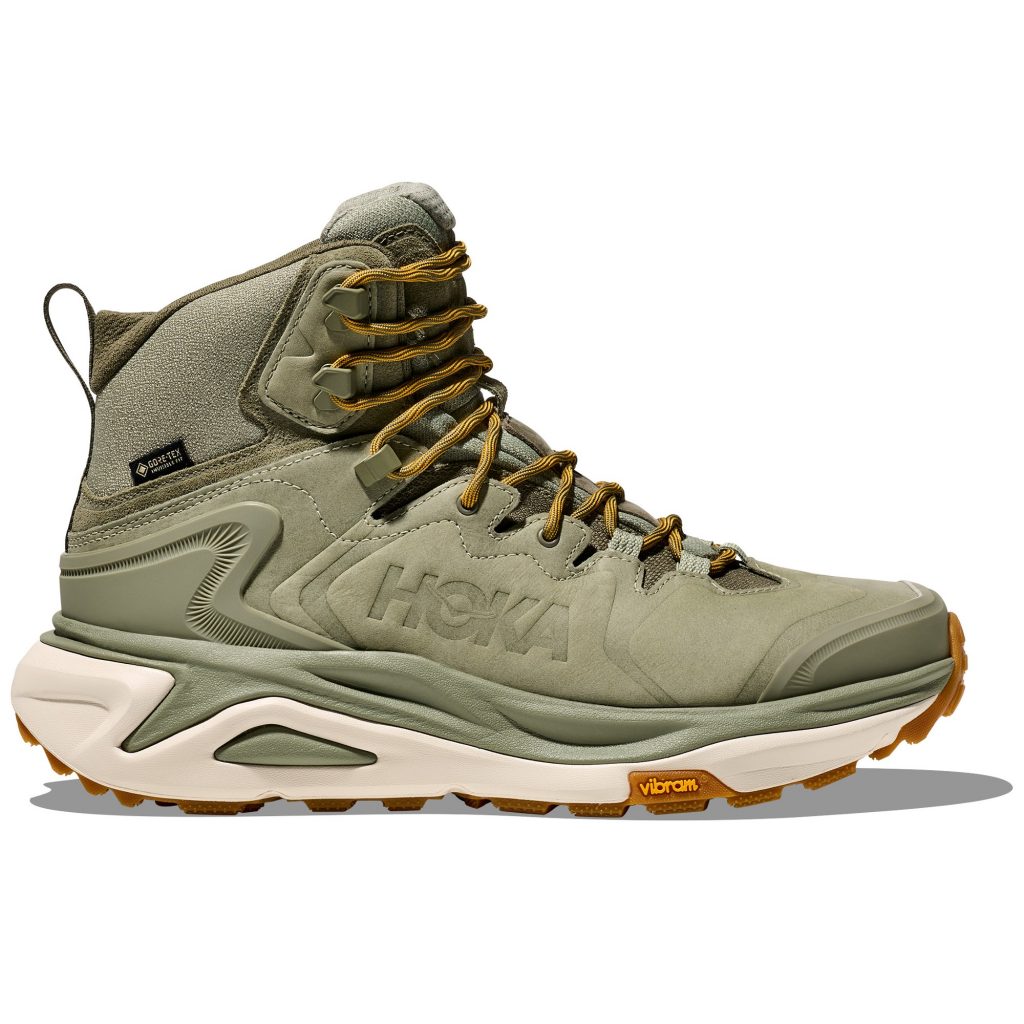
Available In: Men’s, Women’s
Weight: 20.9 oz
Upper Material: Nubuck leather/polyester
Lining: GORE-TEX
Outsole: Vibram Megagrip
Pros: Small break-in period, premium materials
Cons: Short tongue and can ride under laces
Hoka is a love ’em or hate ’em brand when it comes to their aesthetic, but no one can disagree with their level of comfort. The “walking on a cloud” sensation really is a thing, and yet it didn’t take away from the hiking experience, where you couldn’t feel what’s under you too much. While both the max-cushioning and barefoot-style camps have good arguments for theirs and against the others, we will say that after hiking around all day in the Kaha 3 GTX, fatigue simply wasn’t there. Is the boot doing too much work? Perhaps, but the lack of sore tendons isn’t necessarily a bad thing to most people.
The new version has a few changes over the Kaha 2. First, it did get slightly heavier, but it wasn’t noticeable on the foot. Likely, the weight is distributed evenly throughout. The looks of the Kaha 3 are vastly improved, to our mind, and these are a lot less gaudy looking. Finally, we think the outsole is the best one yet—it’s stable, grippy, and naturally rolls through your stride.
Comfort-wise, Hoka hit this one out of the park. The Nubuck leather upper felt great on first wear, and we were surprised that for such a relatively light boot, you could get so much primo cushioning out of it. Maybe they could have sacrificed an extra ounce or two to make a bit larger tongue, which we found to be the weak point on the boot where it would bunch up under the laces, especially when pushing up steep inclines. That was really it, though, and otherwise, we found this a comfortable, durable, and waterproof boot that could stand toe-to-toe with the best of ’em. You’ll just have to decide if you’re a max-cushioning person or not.
Check Men's Price on REI Check Women's Price on REIAku Rocket Mid GTX ($220)
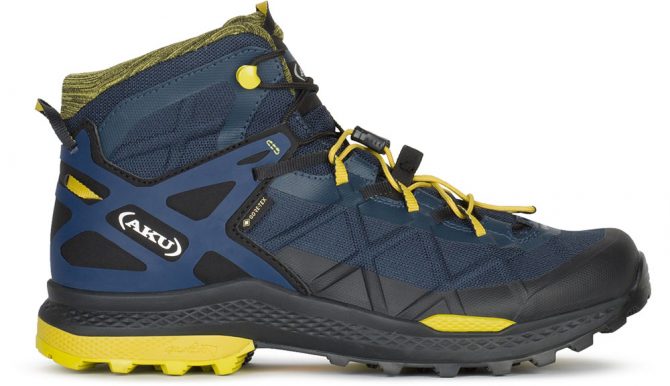
Available In: Men’s, Women’s
Weight: 15 oz
Upper Material: Synthetic / Microfiber
Lining: GORE-TEX
Outsole: Vibram Megagrip
Pros: Speed laces provide a secure fit
Cons: Colorway might be too flashy for some
Aku is not a brand that we’ve had a ton of prior experience with, but its Rocket Mid GTX is a boot we quickly fell in love with. Not only is this boot one of the lightest we tested, but it also had a pleasing fit right out of the gate.
And despite all that lightweight comfort, the boot is solidly waterproof with a GORE-TEX lining. We submerged these boots right up to the top of the laces, and our socks still came out dry. It was also the only model in this test with the quick-pull speed lace system that ended up holding tight, even on long hikes.
These boots had an incredible fit, and yes, we realize that “fit” is a very subjective metric. But in this case, we think the comfort springs from being just flexible enough for a wide variety of feet and ankles while still providing the support of a true hiking boot.
Some people may find the boot too “flashy” with its contrasting colors, so style points had to suffer there. But performance-wise, you can’t go wrong with the Rocket Mid GTX.
Danner Mountain 600 Leaf GTX ($220)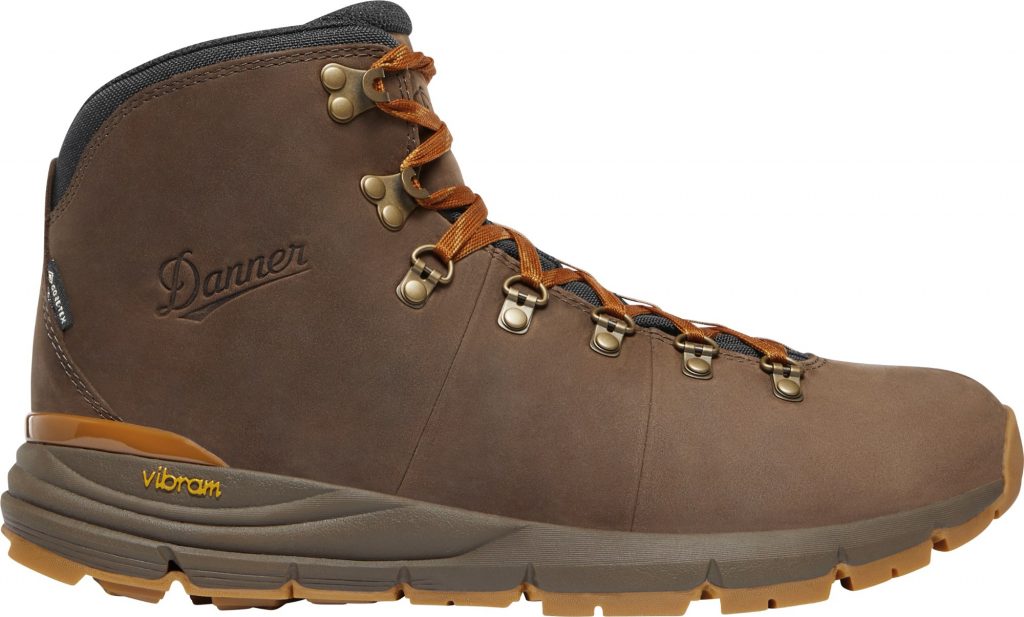
Available In: Men’s, Women’s
Weight: 18 oz
Upper Material: Suede
Lining: Danner Dry
Outsole: Vibram Megagrip
Pros: Stylish, comfortable, good traction
Cons: Not as waterproof or breathable as other models tested
Danner has been around for over 90 years and, in that period, has developed hiking boots that not only work well but look good at the same time. The Mountain 600 Leaf GTX fits that mold. With a suede leather upper, the boot has a classic look, feels comfortable early on, and only gets better with each step as it breaks in. Best of all? The newer “Leaf” version is both lighter than the original 600, and it’s recraftable, meaning you can send it into Danner to get re-soled.
However, being suede, it isn’t as easy to clean when it gets muddy and takes a bit of extra care on the maintenance side. But the combination of a thick sole and minimal seams makes this boot one of the better examples of a rugged day hiker that can also put in plenty of miles on overnights.
The more you wear these boots, the better the fit becomes, and we could really feel the Vibram SPE midsole offering responsive cushioning. The brown leather version is a looker as well, with the classic metal eyelets and red laces to give you a more refined style. But for the suede model we tested, the comfort is what truly made it stand out.
Read our full review of the women’s Danner Mountain 600 here.
La Sportiva Nucleo High II GTX ($239)
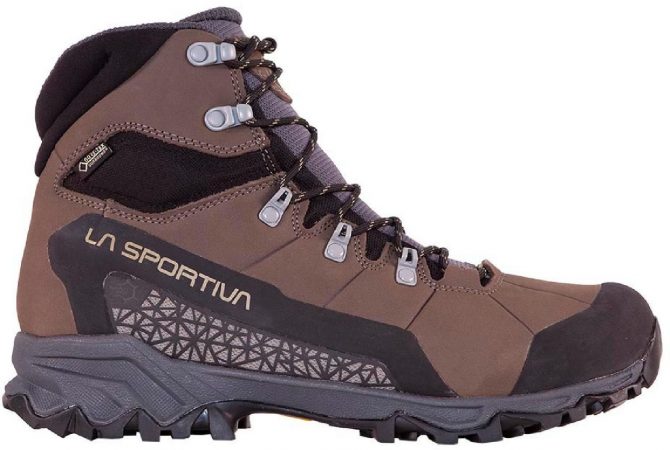
Available In: Men’s, Women’s
Weight: 16.5 oz
Upper Material: Nubuck Leather
Lining: GORE-TEX
Outsole: Vibram Nano Xs-Trek
Pros: Excellent support and traction
Cons: Top half of the boot felt loose
For the price of these boots, you will be hard-pressed to find something that checks so many boxes: lightweight, supportive, waterproof, and comfortable.
The soles had plenty of cushion and felt excellent on the downhill, even with our tester mentioning the uppers felt a bit loose. For someone with a slightly wider foot, this could be the boot of choice on bigger days where lightweight support is essential.
Utilizing both GORE-TEX and La Sportiva’s proprietary Nanocell tech, the La Sportiva Nucleo High II GTX is a remarkably waterproof and breathable boot that was one of the lightest models we tested. For those who have a bit more to spend but don’t want to break the bank, the Nucleo High II GTX could be the ideal boot to cover all the bases.
Check MEN'S Price on REI Check MEN'S Price on BACKCOUNTRY
Check Women's Price on REI Check Women's Price on Backcountry
Salomon Quest 4 GTX ($230)
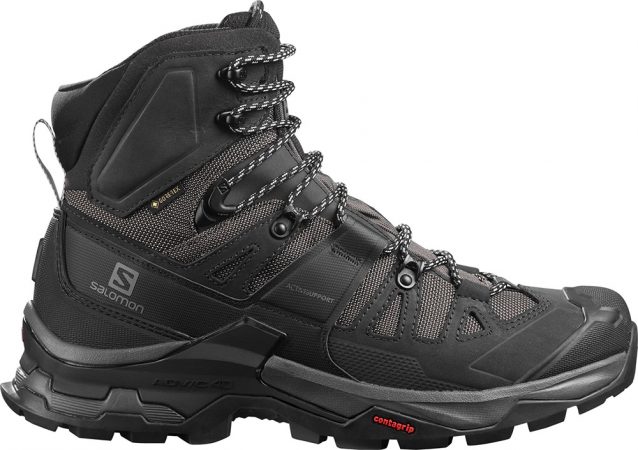
Available In: Men’s, Women’s
Weight: 23.2 oz
Upper Material: Textile/Leather
Lining: GORE-TEX
Outsole: Contragrip TD
Pros: Lightweight for an expedition-style boot
Cons: Sole wasn’t as grippy as others in its class
The Salomon Quest 4 GTX is a beast. We found the sizing to be the roomiest among all boots tested, so sizing down at least half a size would be a good decision for most users.
Despite the high top coming up above the calf, the Quest 4 GTX was breathable enough not to feel as though the foot would overheat. While the midsole felt springy and responsive, we found the outsole slipped more than other models with similar tread patterns, so we had to dock a few points in the traction department.
If you need a good overnight boot that is responsive and pain-free but you don’t have a huge budget for some of the other boots, this might be for you. But if you go out regularly and want something to last more than a few years, it might be worth investing in some expedition boots at a higher price point.
Check Men's Price on REI Check Men's Price on Backcountry
Check Women's Price on REI Check Women's Price on Backcountry
Oboz Sawtooth X Mid ($180)
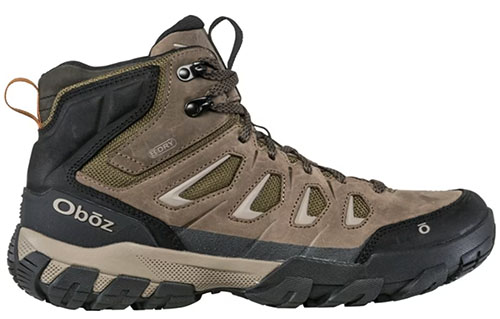
Available In: Men’s, Women’s
Weight: 15.7 oz
Upper Material: Oiled Nubuck Leather/CORDURA fabric mesh
Lining: B-Dry Membrane
Outsole: True Tread Rubber
Pros: Low price point, great support
Cons: Laces can stick when lacing up/loosening
Oboz is based in Bozeman, Montana, where you can’t avoid nature even if you try. The brand is a B-certified corporation, meaning its efforts are recognized for benefitting society as a whole, not just to make shareholders a pile of money. This is all great, but what about making a good product? Thankfully, they also excel here.
Their Sawtooth X Mid is a solid hiking boot that felt great right out of the box and held up well on the trail. The sole is thick enough to withstand anything you throw against it, and although not GORE-TEX like many in its class, Oboz’s proprietary B-Dry lining held up well throughout the testing process. The only issue was that the Sawtooth X Mid is a bit more difficult to lace up than other boots we tested. However, once tight, the laces stayed that way throughout the day without worry.
At one of the lowest price points on the list, these boots have incredible value and are a great option for someone who wants to vote with their wallet to help good companies do good things with their money while also getting a solid hiking boot that can handle a heavy pack.
Check Men's Price on REI Check Men's Price on Backcountry
Check Women's Price on REI Check Women's Price on Backcountry
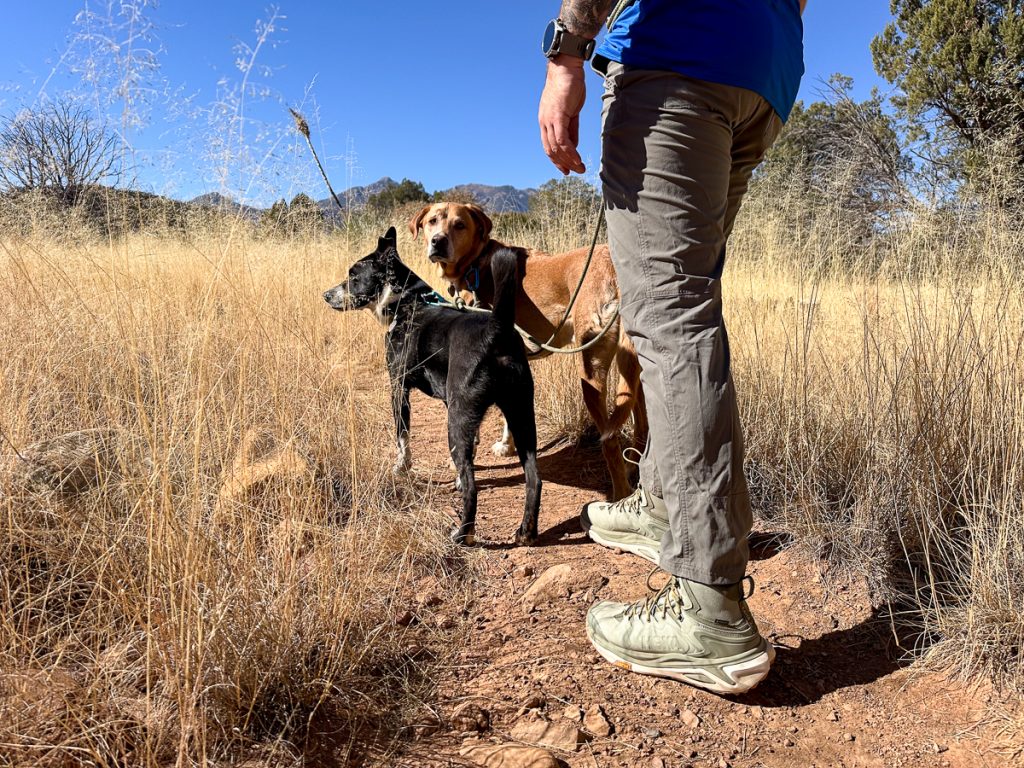
Testing, testing: Trying out hiking boots is fun work. Photo: Nathan Lemin//The Inertia
Hiking Boots Comparison Table
| Model | Price | Weight | Outsole | Upper | Waterproofing | Available In |
| Lowa Renegade Evo Mid GTX | $265 | 20.3 oz | Vibram | Nubuck leather | GORE-TEX | Men’s, Women’s |
| Scarpa Kailash Trek GTX | $319 | 21 oz | Vibram Biometric/ XS Trek | Suede and nylon | GORE-TEX | Men’s, Women’s |
| Merrell Moab 3 Mid | $150 | 17 oz | Vibram TC5+ | Pigskin/mesh | waterproof membrane | Men’s, Women’s |
| La Sportiva TX Hike Mid GTX | $189 | 14.2 oz. | Vibram Ecostep EVO | Recycled air mesh and no-sew upper, nylon webbing, welded TPU overlays | GORE-TEX | Men’s, Women’s |
| Zamberlan Tofane NW GTX RR | $495 | 29.5 oz | Zamberlan Vibram NorWalk | Full-grain waxed Tuscan leather | GORE-TEX, waxed leather | Men’s, Women’s |
| Xero Shoes Ridgeway | $140 | 13 oz | Feeltrue Rubber | Suede/polyester | 3L Construction with Hydroguard 50 membrane | Men’s, Women’s |
| Vasque St. Elias | $230 | 23 oz | Vibram Megagrip | Full-grain/nubuck leather | GORE-TEX | Men’s, Women’s |
| Hoka Kaha 3 GTX | $240 | 20.9 oz | Vibram Megagrip | Nubuck leather/polyester | GORE-TEX | Men’s, Women’s |
| Aku Rocket Mid GTX | $185 | 15 oz | Vibram Megagrip | Synthetic fabric/microfiber | GORE-TEX | Men’s, Women’s |
| Danner Mountain 600 Leaf GTX | $220 | 18 oz | Vibram Megagrip | Suede leather | Danner Dry | Men’s, Women’s |
| La Sportiva Nucleo High II GTX | $239 | 16.5 oz | Vibram Nano XS-Trek | Nubuck leather | GORE-TEX | Men’s, Women’s |
| Salomon Quest 4 GTX | $230 | 23.2 oz | Contragrip TD | Leather/textile | GORE-TEX | Men’s, Women’s |
| Oboz Sawtooth X Mid | $175 | 15.7 oz | True Tread Rubber | Oiled nubuck leather | B-Dry | Men’s, Women’s |

Testing out a pair of hiking boots on the Chief, in Squamish, BC. Photo: Steve Andrews//The Inertia
How We Tested Hiking Boots
Testing out hiking boots requires a lot of — you guessed it — hiking. But it’s not that simple. We went on hikes of all shapes and sizes, from one-hour jaunts to multi-day, overnight treks out in the wilderness. Since hiking boots often have a break-in period, we aimed to put in as many miles as we could on each pair of boots until they felt as though they were properly broken in.
Due to its size, most of our testing team got involved in this guide. Primary testers included Steve Andrews and Rebecca Parsons, but other contributors and one of our editors, Nathan Lemin, lent their testing and expertise as well.
Real-World Testing
With such a wide range of boots to test, it made sense to save the heavier boots for the bigger excursions and the lighter ones for the sessions without a pack. When possible, we would take several pairs so that we could compare them as closely as possible.
Waterproofing was also tested, making sure we submerged each pair for at least a minute to see whether they were indeed waterproof. Thankfully, every pair listed here passed that test, with dry socks underneath and, for the most part, no water coming in through the top when the boots were properly done up.
Speaking of doing up boots, lacing up was a key factor in the ratings, mostly fitting in the comfort and support scores. Here are the performance metrics we looked at.
Durability
How well do the boots hold up after logging miles all summer? Do they show signs of wear or look/feel great after putting them through the ringer?
Support
Do the boots feel stable in uneven terrain and with a pack? Note: we gave some leeway with lighter boots when holding a heavy pack since they are not intended for massive overnight treks.

Testing the Scarpa Kailash Trek GTX out in the wild Photo: Lindsay Gough//The Inertia
Traction
Can the boots stay put on wet rocks, roots, and through mud?
Comfort
Are the feet and ankles happy throughout the hike, or does soreness creep in the more miles you log? Note: Some of the boots require a longer break-in period, and we did our best to factor this in, as long as they did eventually break in after 20 or so miles underfoot.
Style
Yes, style points do matter, although we tried not to let this be a major determining factor compared to other criteria.
For the terrain, we compared the boots in a variety of environments, from the coastal granite of the PNW to the dusty inland trails of the Sawtooth mountains, making sure the traction held up. All weather conditions were important, of course, so these boots have been in mud, rain, and blistering heat. Then we did it over and over again to see how the boots held up after continued abuse. If it wasn’t up to snuff, it didn’t make this list, and there were plenty that didn’t get a recommendation.
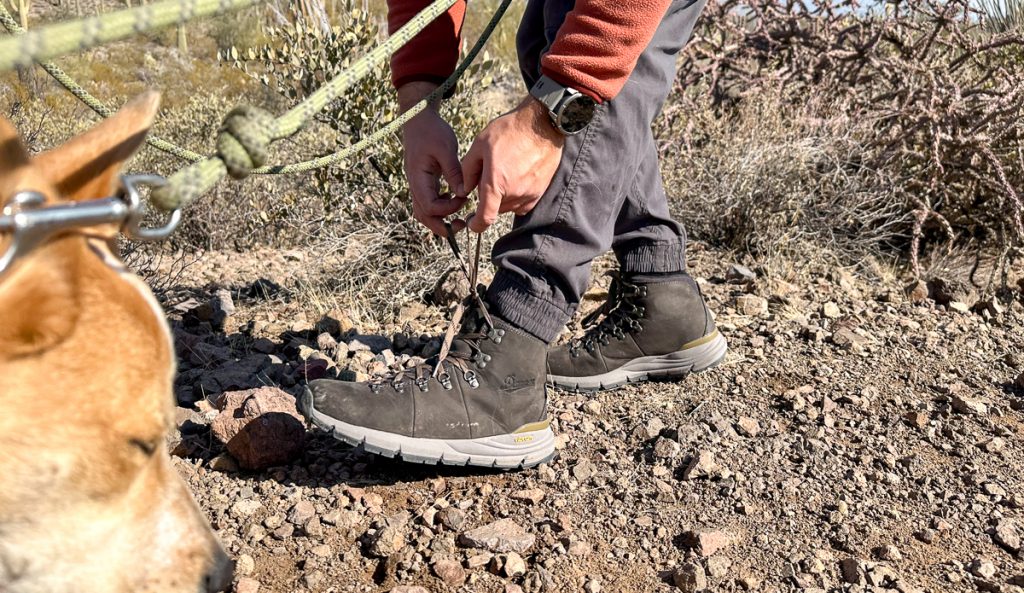
There are plenty of great hiking boot options, what should you look for? Photo: Nathan Lemin//The Inertia
Hiking Boots Buyer’s Guide
Hiking boots are a broad category, so knowing your needs and understanding which hiking boot performance factors best match those needs will go a long way toward helping you make an informed decision.
Fit
This is the most important factor. Even the best hiking boots won’t serve you well if they don’t fit properly. Make sure there’s enough room for your toes to move, but not so much that your feet slide inside the boots. When trying on the boots, you want to make sure that your toes aren’t pressed too tightly to the front, otherwise, your downhill descents will be painful. On the other side, make sure your heel doesn’t lift when on the ascent, or your day will end with massive blisters.
Hiking boots should be half a size to a full size larger than your regular shoe size to accommodate thicker hiking socks and foot swelling during long hikes. Keep in mind that some boots, especially those made of leather, require a break-in period before they become comfortable.

Despite the lightweight, synthetic materials, The Aku Rocket Mid GTX did just fine in the muddiest of conditions. Photo: Steve Andrews//The Inertia
Material
Materials can largely determine the boot’s durability, breathability, and water resistance. Full-grain leather offers excellent durability and abrasion resistance, but is usually less breathable. The Zamberlan Tofane NW GTX RR stands out for the leather quality, but it was also the heaviest on our list. Synthetic materials like nylon and polyester are lightweight, breathable, and break in quickly but can be less durable.
Waterproofing
If you plan to hike in wet conditions or cross streams, waterproof boots are essential. However, they tend to be less breathable. GORE-TEX membranes are popular for their combined waterproofing and breathability. Our favorite was the Lowa Renegade Evo Mid GTX. Some brands use their own proprietary waterproofing, such as the Merrell Moab 3 Mid.

Don’t forget to test the waterproofing! The Zamberlan Salathe GTX RR and their Hydrobloc aced it. Photo: Steve Andrews//The Inertia
Breathability
Breathable boots are great for dry, hot environments. They help to dispel the sweat, keeping your feet dry and reducing the risk of blisters. However, breathability and waterproofing tend to work against each other. If you don’t absolutely need waterproofing, it’s best to opt for something without a liner.
Weight
Lighter boots, such as the Xero Shoes Ridgeway, are easier to move in, but they may offer less support and cushioning. Heavier boots like the Zamberlan Tofane NW GTX RR can provide more support and durability, but may tire you out more quickly. It’s important to factor in the type of hiking you do before honing in on whether to get a lightweight hiking boot or a more rugged pair.
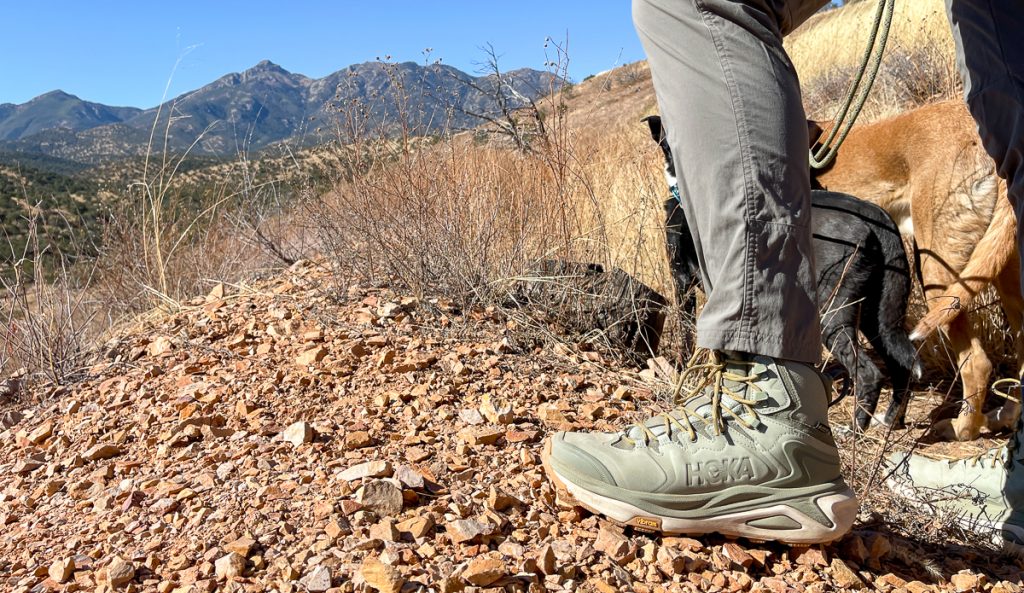
Outsoles like the Vibram MegaGrip provide excellent traction. Photo: Nathan Lemin//The Inertia
Traction
Check the boots’ outsoles. Deep, thick lugs like those on the Lowa Renegade Evo Mid GTX help in muddy conditions, while a heel brake like on the Hoka Kaha 2 GTX can reduce the chance of sliding during steep descents.
The treads on the bottom of hiking boots are called lugs. Deeper and more widely spaced lugs are ideal for muddy and uneven terrain. Shallower and closely spaced lugs are better for hard-packed terrain.
The rubber compound of the outsole affects grip and durability. Softer compounds offer better grip but wear out faster, while harder compounds are more durable but less grippy. Vibram has been a leader in this space for over 80 years, and as far as outsoles go, it is the leading brand name that people look for.
Durability
This is determined by the materials and the construction of the boot. Boots with fewer seams and high-quality materials tend to last longer. Leather boots such as the Lowa Renegade Evo Mid GTX will hold up and break in for more comfort as time goes on. Also, look for extra reinforcement around the toe and heel, the common wear-out points. This will help extend the lifespan of the boot, especially if you’re hard on your gear.
Comfort and Support
Look for adequate padding in the collar and tongue for added comfort and to prevent chafing. High-top boots like the Lowa Renegade Evo Mid GTX or Zamberlan Tofane NW GTX RR provide more ankle support, which is crucial for rough terrain or carrying heavier loads. Consider the boot’s arch support, especially if you have specific foot conditions like flat feet or high arches.
The midsole, which provides cushioning and shock absorption, can be made of EVA (lighter and softer) or polyurethane (firmer and more durable). Hoka takes this to the max with the Hoka Kaha 2 GTX. Barefoot models such as the Xero Shoes Ridgeway leave it to the muscles in your feet to offer support, letting you feel the ground underneath. Consider the stiffness of the midsole based on the type of terrain you’ll be hiking. A stiffer midsole offers more support on uneven terrain.

Testing a few boots at a time to make the comparison as objective and straightforward as possible. Photo: Steve Andrews//The Inertia
Hiking Boots Closure System
Look for a secure and easy-to-adjust lacing system. The Lowa Renegade Evo Mid GTX stood out for easy-to-tie laces with a secure fit. Many boots have hooks or eyelets at the top for a snug fit around the ankle, which helps keep it tight over the long haul.
Additional Features
A rubber toe cap can protect your toes from rocks and roots. If you plan to hike in snow or loose debris, check if the boots are compatible with gaiters. For environmentally-conscious hikers, look for boots made with sustainable materials and ethical manufacturing practices.
Maintenance and Care
To keep your hiking boots in top condition, clean them after each hike. Use a brush to remove dirt and mud, and rinse them with water if necessary. Avoid exposing them to direct heat when drying; instead, let them air dry naturally.
If the boots have a removable insole, take it out to dry separately. For leather boots, apply a conditioner or leather treatment periodically to keep the leather soft and prevent it from drying out and cracking. This will also help maintain the boot’s water resistance. Follow the manufacturer’s recommendations for the type of conditioner to use.

Scarpa’s Kailash Trek GTX handled the rugged terrain of Idaho’s Sawtooth Mountains without any fuss. Photo: Lindsay Gough//The Inertia
Final Thoughts
While it’s important to stick to your budget, investing in a quality pair of hiking boots can save you money in the long run. Cheaper boots may wear out faster and need to be replaced more often, while a well-made pair can last for many seasons with proper care.
Ultimately, the best hiking boot for you is the one that fits well, meets your needs for the type of hiking you do, and feels comfortable on your feet. Take the time to try on different styles and brands, and don’t be afraid to invest in your comfort and safety on the trail.
Return to Comparison Table | Return to Top Picks
Editor’s Note: We’ve also tested a wide range of hiking shoes, which are worth checking out for casual day hikes up to longer, ultralight backpack missions. If you are looking for something even more breezy, try our guide to the best hiking sandals. We’ve also reviewed women’s-specific hikers in our Best Hiking Boots for Women and Best Hiking Shoes for Women articles. For more gear reviews and features on The Inertia, click here.



